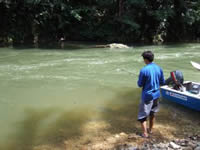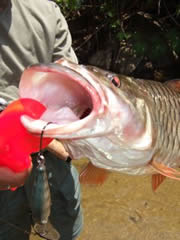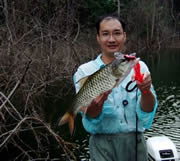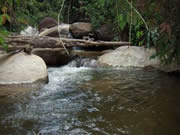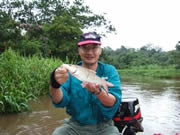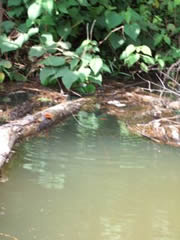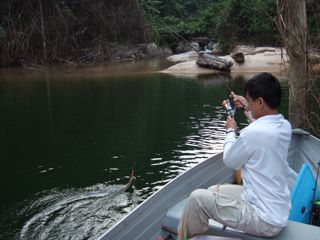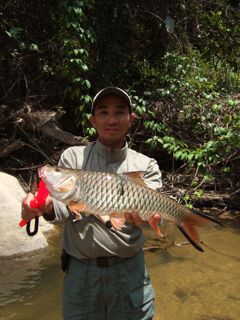
Sebarau haunts
Keen sebarau / hampala barb anglers are passionate about their favourite quarry. Though it may belong to the carp family, it is a very special kind of carp as it is very aggressive. It readily attacks lures, unlike other carp species in our waters. Incidentally there are other carp species in the African and Indian subcontinent that take lures as well, and they too have a lean and mean shape like our sebarau.
In the past, sebarau (a.k.a. Hampala Barb) could be considered a common catch in the dams and rivers before habitat destruction, pollution and over fishing took their toll. Thus these days they are harder to find, but if you know where to look, they can be found. Like any other fish, the sebarau like to hang out near their food source or their restaurant of choice. Naturally, they like us humans, want cheap (preferably free), abundant and tasty food. So the “seats” or “tables” with those criteria will be the ones that can be chock-a-block full of sebarau customers.
There are very few studies on sebarau, but the few that have been done show that they are mainly piscivorous though in some areas their diet does include aquatic insects. A Piscivore is a carnivorous animal which lives on eating fish, and this is what makes it so appealing to lure casters. Knowing that the carnivorous sebarau’s main forage is fish allows the angler to better understand their choice of habitat. Therefore where the forage is to be found, or easily devoured, is their dining area. However there is another reason why sebarau can be found shoaling in certain areas during a certain season which is not so much related to food, but we will look at that later.
Places that most sebarau anglers know where shoals of forage fish commonly congregate are streams or river mouths feeding into running water (rivers) or still waters (ponds, lakes, impoundments/dams). The water flowing from streams or rivers brings down with it food for the forage and also the forage. The sebarau (and other piscivores) will shoal around these areas waiting to feed on their forage. The forage can be tiny, tiny fish, sometimes only a centimetre in length or as large as they will fit into the mouth of the sebarau.
Interestingly enough, though the sebarau is a carnivore, it has no teeth. The lips around the mouth of the sebarau are tough and leathery, covering some very hard bones that are part of the jaws. Therefore it will only be able to consume fish that it can swallow. It will ingest the baitfish with a gulp and then break it down in the esophagus or gullet before it goes into the stomach. Small baitfish are quickly ingested into the stomach, whereas for a large baitfish it takes quite a while for it to be broken down in the gullet. Often a sebarau in an aquarium can be seen with the tail fin of a large food fish sticking out of its mouth while it breaks down the fish in its gullet before the fish enters its stomach.
At times the sebarau will be hunting in packs around the river mouth when the food is swept out from the river in abundance or if the same food is attracted to the river mouth in abundance schooling in the area to feed on whatever is their own forage being swept out of the river.
Sometimes when this happens the fishing can be very hot for even the whole day!
The sebarau will continue feeding even when the sun is high! This of course is a delight, but unfortunately the locals tell me it can be difficult to predict when this happens. It mostly happens when there has been a period of heavy rain for the last few consecutive days. However this type of weather conditions does not necessarily prelude this type of fishing. Not all river mouths may have this sort of action, as there are some river mouths that we have never seen this hot action happen.
When the forage is not as abundant around the river mouth, the sebarau will locate themselves strategically at the best spots where they can pick off the morsels swept by. These are often places which allow them to hold within minimum expenditure of energy. It could be in front or behind a rock or branch which creates an area of dead water, or a depression, point or drop off that creates eddies and quiet areas to hold while the current sweeps the food past them.
This type of scenario is the more typical situation for most river mouths. Therefore identifying the above water structure like protruding timber and rocks will pinpoint possible sebarau ambush points. For the submerged structure, if the water is clear, the structure will be easily made out. Other clues would be to look at the current flows, identifying eddies and ripples that indicate what lies beneath. A high tech method would be to use a “fish finder” to read the bottom structure. Alternatively when the water level is low during the dry season, take a good look at the area and memorise the promising looking spots. Taking a few snap shots with a camera is not a bad idea too.
These same areas, especially behind structures like branches, logs, points or sharp drop offs make good ambush points for the sebarau to hide behind, surprising the unsuspecting forage swimming by as it feeds on the smorgasbord of food fare brought down by the river. The first sebarau I caught was in a spot exactly like this. We were fishing under a river that crossed beneath a highway. Just upstream lay an old fallen tree. By casting the lure upstream and then cranking it down with the current past the branches, making it look like a baitfish might be swimming along with the current, I managed to hook and land land my first sebarau.
By now it should be quite obvious that the sebarau are like most predators, they are structure based piscivores. Therefore they also will be structure based in rivers and still waters. In rivers the structure is not only an ambush point, but a place for it to lie in wait amidst the currents swirling by without expending unnecessary energy. For locations in still waters, the structures make good ambush points to camouflage themselves, waiting to dart out and nab an unsuspecting morsel of food casually cruising by.
Another kind of structure that sebarau can be commonly caught from are aquatic plant beds or around flooded weed beds. These areas are ideal habitat for small baitfish and fish fry, offering food and protection. However predators will hang around or cruise along the edges of these areas, waiting to pounce on their hapless victims that may venture close to the edge of the weed beds. This normally happens in the early morning or late evening, when the small fish get careless and tend to put themselves closer to harms way.
This however may change over time. For instance one dam had plenty of small sebarau that were caught around the edges of aquatic plant beds. Then there was a drought and when the water level dropped, these plant beds died and the sebarau moved to new types of structure and could be found around branches and logs.
Though these are the common areas that sebarau may be caught from, there is more to it than that. Not at every structure, point, drop off or weed bed will there be sebarau to be caught. There are many more factors that come into play that cause sebarau to locate themselves in some structures and not in others. Anglers often come up with theories on these factors, and these factors can be considered theoretical, as there is much we do not know about the complicated ecological balance of the sebarau and their habitat. Therefore we will leave these theories alone till they can be better substantiated.
Sebarau can also be found feeding on occasions in open water and not associated with structure. Once I was in Bukit Merah near the resort jetty in shallow water and the place went alive for half an hour with sebarau chasing bait everywhere. We managed to catch some using the right lures and techniques. Why that happened we do not know except that now and then it happens, which is not very often at all at this venue. So if a situation like that is encountered it is of course best to make the full use of it.
Sebarau can also often be seen feeding in schools, both small and big in the large and deep open waters of impoundments. They will appear splash for a few seconds and disappear, only to appear again a hundred metres away moving rapidly and in a random direction. Trying to predict when and where they will surface is almost impossible and even getting there in time is unlikely. We have spent much effort and time trying to get these sebarau with no success to date.
There was once when we saw some feeding going on in the middle of the bay that was ten metres deep. Not exactly sure what was happening, we motored over to take a look and on my sounder were masses of perfect fish arches, a very rare sight in our dams. After some trial and error with different lures we began to catch a bunch of sebarau in the one kilo range for an hour before the sebarau disappeared. This happened for two consecutive days, but on many subsequent trips we have never again seen this happen. I guess the conditions of the water, suspended matter, baitfish and maybe even the moon phase have to be in just the right combination.
Another reason sebarau may be caught at river mouths which is not necessarily associated with feeding is during the start of the rainy season when the water level in the river rises. It is common local knowledge that during this period the sebarau make their way upstream to spawn and anglers will find them congregating at the river mouths. Of course also during the rainy season when the water level rises and larger amounts of water are washed down the rivers, there will be a greater abundance of food found in this area.
Probably the most important factor to being able to find sebarau is local knowledge. The anglers who frequently are successful in their catch normally have fished the area consistently and know which structure or areas the sebarau frequent. For instance no two dams are the same. I know of two dams that are located next to each other. One has sebarau that can be found in classic wood structure and surprisingly the other is very different. The sebarau are not found in the same type of wood structure but more in open water and rock or ledges near flowing water. Having valuable local knowledge increases the catch.
Overall, sebarau are most consistently found around fixed structure, but even then when the conditions change, the sebarau may disappear. The cause of this can be numerous, for instance the change in water level, chemical composition, clarity, or even external effects like over fishing, netting or poison can cause this disappearance.
To sum it up, sebarau are found where they can find food. Knowing where they can find food will lead the sebarau hunter to them. Also one should not have fixed ideas as to where sebarau can be found. The locations listed in this article are only generalities and sometimes one can get a surprise as to where they can be caught! There are no rules here, but only guidelines. Good powers of observation will assist in finding productive locales; in other words work at it and gain local knowledge.
Conservation
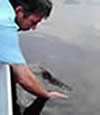
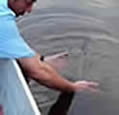
We need to protect and conserve our resources by practising catch and release of our sportfish and protecting the habitat of our fishes.
